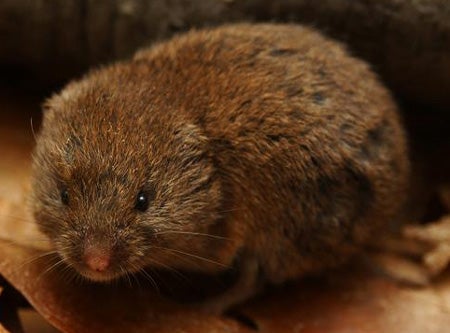SCIENTIFIC NAME:
Microtus pinetorum
OTHER NAMES:
Pine vole, pine mouse, mole mouse, potato mouse, mole pine mouse, bluegrass pine mouse.
STATUS:
Found statewide, except for southwestern section. Low Conservation Concern.
DESCRIPTION:
Woodland voles (Microtus pinetorum)are members of the Order Rodentia and Family Muridae. Newborn voles have no external hair, except whiskers, or dermal pigment. They develop their juvenile pelage by 9-10 days of age. Adult pelage starts to grow at about eight weeks of age.
Voles undergo three molts – juvenile, subadult, and adult. The juvenile molt occurs between the juvenile and subadult pelage; the subadult molt occurs between the subadult and adult pelages; and the adult molt occurs seasonally. The summer adult molt occurs from May to June and the winter molt occurs in November and December. Adult pine voles have short, thick, soft, reddish-brown fur above and grayish, washed with buff fur below.
Voles spend most of their time in tunnel systems one to several inches below the surface. At night, they come above ground and feed, but they may be active at any time of the day or night. Pine voles usually construct burrows by digging with their forefeet and incisors, and pushing back the dirt with their hind feet. Woodland voles usually have home ranges of about 450-500 square feet, tending to stay in an area as small as 1,000 square feet for their entire lives. They may be a problem in fruit tree orchards, where they girdle young trees and damage roots. However, since woodland vole burrows are so close to the surface, their numbers usually can be controlled by cultivation.
Their vocalization is a harsh chatter, with one to five notes per call. The eyes and ears of woodland voles are reduced in size compared to many other species of mice because voles spend nearly all of their time underground. Their ears are small, rounded, and only slightly longer than the fur. The eyes of woodland voles are smaller than those of most other vole species. Voles have a short reddish-brown tail (1/2” to 1-1/8”) that is not much longer than the hind foot. Their overall length is 4-1/8” to 5-3/4”. Adults weigh between 5/8 and 1 3/8 ounces. There is no size difference between males and females.
DISTRIBUTION:
Woodland voles are found from the eastern U.S. west to Nebraska, Kansas, Oklahoma, and central Texas; south from Wisconsin and New England through the southern states. woodland voles usually are not found in coastal areas in these states because most soils in these areas are not suitable for burrowing.
HABITAT:
Woodland voles live primarily in deciduous forests with thick leaf mold or thick herbaceous ground cover. They sometimes are found in park-like grassy areas next to woodlands. Woodland voles are most abundant in deciduous forests with moist, friable soils suitable for burrowing, but can also be found anywhere from dry fields to the edges of coastal bays
FEEDING HABITS:
Woodland voles feed primarily on forbs, grasses, roots, flower bulbs, and tubers, but also will eat seeds, fruits, bark, a few insects, and underground fungi. They go above ground at night to feed on bark, fruit, and tender vegetation. They store large amounts of food in underground caches.
LIFE HISTORY AND ECOLOGY:
Woodland voles live underground in their burrow systems during most of their life. Their home range typically covers an area of only 450 to 550 square feet, with most pine voles never venturing outside an area as small as 1,000 square feet for their entire lives. Woodland voles are somewhat colonial, although colonies sometimes disband and disappear for no apparent reason. A single burrow system and nest may accommodate social groups containing many adults of both sexes and their young. Densities are usually greater in fruit tree orchards than in natural hardwood forests.
This species does not show population cycles, although it varies greatly in number through time. This is due primarily to its relative lack of predators. Its main predators are hawks, owls, foxes, and snakes. Pine voles can reproduce year-round in the South and in late March through August or September in the North. Voles produce one to four of one to five young per year. Gestation lasts 20 to 24 days.Young voles are born in a nest in the underground burrow. They are pink and have closed eyes and ears. Woodland voles reach sexual maturity at 37 to 38 days and have a life span of at least 18 months.
REFERENCES:
eNature.com, Woodland Vole (Microtus pinetorum)
Layne, J. N. 2003. Armadillo. Pages 75-97 in G. A. Feldhamer, B. C. Thompson, and J. A. Chapman, eds. Wild mammals of North America: biology, management, and conservation. Second edition. The Johns Hopkins University Press, Baltimore, MD and London, U.K.
Nowak, R. M. 1999. Walker’s mammals of the world, sixth edition, volume one. The Johns Hopkins University Press, Baltimore, MD and London, U.K. 903 pp.
Smithsonian National Museum of Natural History, North American Mammals - Microtus pinetorum Woodland Vole
University of Missouri Extension, Pine or Woodland Voles
AUTHOR:
Chris Cook, Wildlife Biologist, Alabama Division of Wildlife and Freshwater Fisheries






